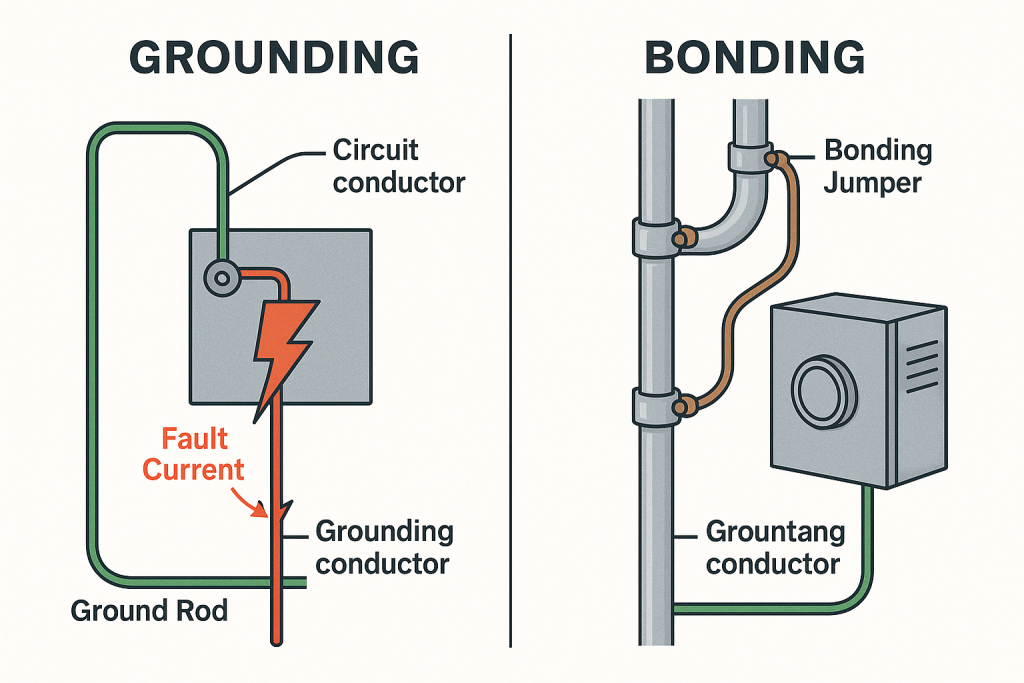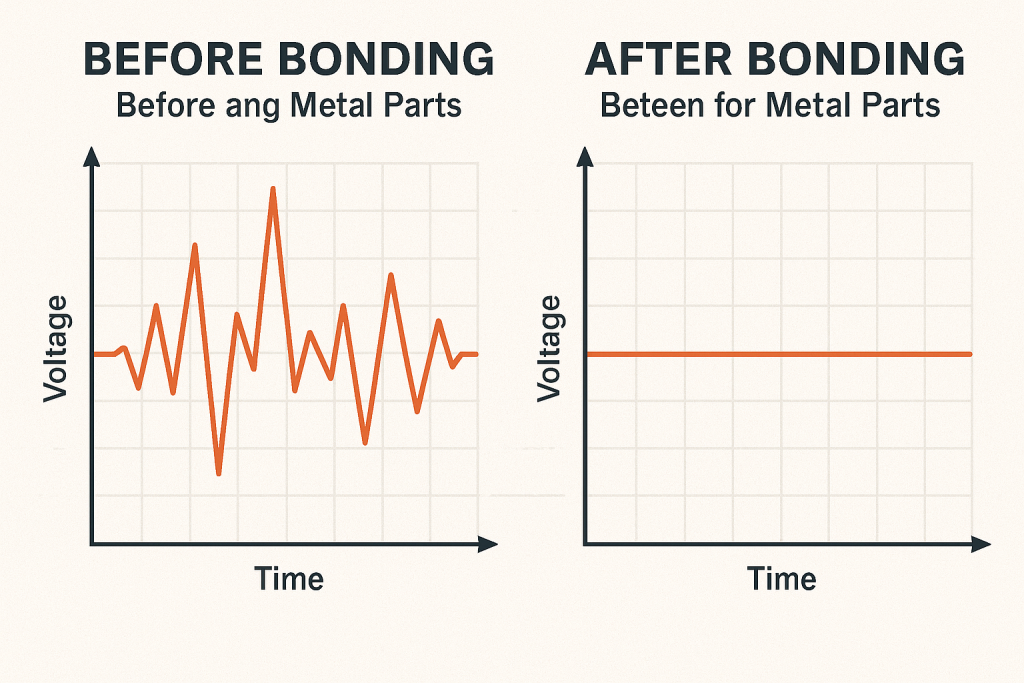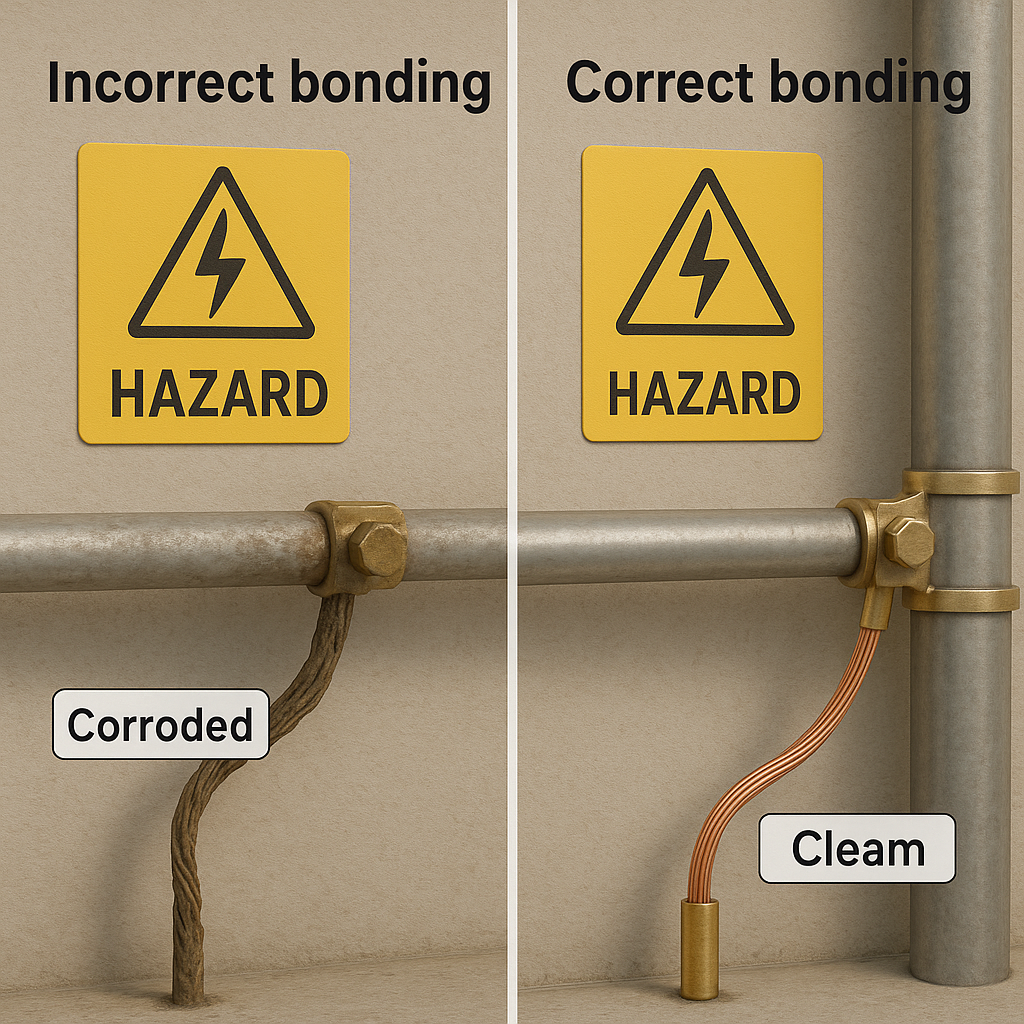
Grounding vs Bonding Differences
Grounding vs bonding differences often spark debate among electricians, engineers, and even curious homeowners. Though these terms sound similar, their functions differ significantly. In the simplest words, grounding connects an electrical system to the earth, while bonding connects metallic parts together to prevent voltage differences.
Both practices aim to protect people and equipment, yet they achieve this in unique ways. Understanding the differences not only ensures compliance with standards like the NEC (National Electrical Code) but also boosts safety and reliability.
Introduction to Grounding vs Bonding Differences
Imagine standing outside during a thunderstorm. The idea of being struck by lightning is frightening, right? In electrical systems, grounding acts as the safe path for that “lightning” or stray current to return harmlessly to the earth. Meanwhile, bonding ensures all metallic parts are at the same potential so that you won’t get shocked by touching two metal objects simultaneously.
These differences are crucial, especially in large commercial buildings, data centers, and critical infrastructure. An incorrect approach can lead to dangerous faults or even catastrophic failures.
Understanding the Concept of Grounding
Grounding is a protective measure in which a conductive path connects parts of an electrical system directly to the earth. Historically, as electrical systems became widespread in the late 19th century, grounding evolved as a necessity to handle fault currents, lightning strikes, and system imbalances.
At its core, grounding keeps equipment enclosures and metallic frames at zero voltage relative to the earth. This approach limits dangerous voltage build-ups, protecting both people and sensitive electronics.
Understanding the Concept of Bonding
While grounding refers to connecting equipment to earth, bonding means connecting metallic parts together. Bonding doesn’t necessarily involve the earth itself—it focuses on ensuring there’s no difference in potential between conductive objects.
For example, in an industrial plant, bonding might involve connecting metallic piping, cable trays, and equipment enclosures so that, during a fault, there’s no dangerous voltage difference between them. Bonding reduces shock hazards dramatically.
Why Distinguishing Grounding vs Bonding Differences Is Crucial
It might sound trivial, but knowing when to ground and when to bond can save lives. Inadequate grounding can cause transient voltages to destroy equipment. Improper bonding can create shock hazards that might injure workers or the public.
Clear understanding also ensures compliance with codes and standards like the NEC or IEC, which make separate recommendations for grounding and bonding practices.
The Science Behind Grounding
Grounding leverages the earth’s vast capacity to absorb electrical current safely. When fault current arises—due to insulation failure or a lightning strike—it flows along the grounding conductor to the earth, reducing the risk of electrical shock or fire.
Interestingly, grounding isn’t just about safety; it stabilizes voltage in power systems by providing a common reference point.
The Science Behind Bonding
Bonding doesn’t rely on the earth; instead, it creates low-impedance paths between metallic objects. This prevents different metal parts from sitting at different voltages, which could lead to arc flashes or shock hazards.
In practical terms, bonding jumpers, busbars, and bonding conductors interconnect metallic systems, ensuring they remain at the same electrical potential.
Primary Objectives of Grounding
- Limit overvoltages caused by lightning or surges
- Provide a path for fault current to flow safely into the earth
- Stabilize voltage in normal operation
- Protect sensitive electronics from transient voltages
These objectives reveal grounding’s central role in modern electrical design.
Primary Objectives of Bonding
- Equalize potential between conductive objects
- Reduce shock hazards from voltage differences
- Prevent arcing between metallic structures
- Improve system reliability by avoiding dangerous loops
Bonding ensures that metal objects people might touch remain equally “electrically neutral.”
Components Used in Grounding Systems
| Component | Purpose |
|---|---|
| Ground rods | Provide earth connection |
| Ground plates | Enhance surface contact |
| Grounding electrode conductor | Connects system to ground |
| Busbars | Distribute ground connections |
| Exothermic welds | Permanent connections |
Each component is chosen based on soil conditions, system size, and fault current expectations.
Components Used in Bonding Systems
| Component | Purpose |
|---|---|
| Bonding jumpers | Connect non-continuous metal parts |
| Busbars | Central bonding point |
| Clamps & lugs | Mechanical connections |
| Metallic conduits | Provide bonding path |
| Bonding conductors | Low-impedance connections |
The selection focuses on minimizing impedance and ensuring mechanical durability.
Common Misconceptions About Grounding
One widespread myth is that grounding itself will always clear a fault. In truth, the effectiveness depends on a properly sized grounding conductor and low enough ground resistance.
Another misconception? That a single ground rod is always sufficient. Soil conditions may require multiple electrodes to achieve the target resistance.
Common Misconceptions About Bonding
Some believe bonding replaces grounding—it doesn’t. Bonding prevents voltage differences; grounding provides a reference to earth.
Another misconception is that small bonding conductors are always enough. In high-fault systems, conductors must handle significant current briefly.

Grounding vs Bonding Differences: Key Comparison Table
| Feature | Grounding | Bonding |
|---|---|---|
| Connects to earth? | Yes | No |
| Purpose | Route fault currents & stabilize voltage | Equalize potential |
| Common path | Ground rods, plates | Bonding jumpers, busbars |
| Depends on earth resistance? | Yes | No |
| Fault clearing? | Helps clear faults | Reduces voltage differences |
| Involves current flow? | Often, during faults | Only under fault conditions |
Real-world Applications of Grounding
- Residential electrical panels connecting neutral to ground
- Utility substations using ground grids
- Communication towers with dedicated ground systems
- Data centers with isolated technical grounds
Grounding remains indispensable in every modern electrical installation.
Real-world Applications of Bonding
- Bonding metal water pipes to the grounding system
- Bonding cable trays to equipment enclosures
- Bonding rebar in concrete floors
- Bonding gas pipes to reduce ignition risk
These practices prevent dangerous potential differences.
Graph on Fault Current Paths
(Graph shows how grounding directs fault current into earth, protecting equipment.)

Voltage Equalization Graph

(Graph illustrates bonding maintaining the same voltage across metallic objects.)
Code and Standards Relevant to Grounding vs Bonding
- NEC Article 250 (Grounding and Bonding)
- IEC 60364 Electrical Installations
- IEEE 142 (Green Book)
- Local building and safety codes
Staying compliant prevents accidents and legal liabilities.
Testing Methods for Grounding Systems
- Fall-of-potential test: Measures actual ground resistance
- Clamp-on ground tester: Fast measurement for existing systems
- Soil resistivity tests: Help design effective grounding
Testing Methods for Bonding Systems
- Continuity test: Verifies metallic connections
- Bonding resistance measurement: Checks low-impedance paths
- Infrared scans: Identify hot spots due to poor bonding
Expert Tips for Proper Grounding
- Use multiple ground rods in rocky soil
- Regularly test ground resistance (aim <5 ohms)
- Use corrosion-resistant materials
- Document ground system design for audits
Expert Tips for Effective Bonding
- Avoid long bonding conductors (lower impedance)
- Secure mechanical connections properly
- Inspect connections periodically for corrosion
- Ensure bonding covers all accessible metal parts
Common Failures and Their Consequences
Improper grounding can cause:
- Equipment failure from transient overvoltages
- Shock hazards due to floating potentials
Poor bonding can cause:
- Arc flashes
- Dangerous voltage differences during faults

Emerging Technologies in Grounding and Bonding
- Smart ground monitoring systems
- AI-driven fault prediction
- Wireless sensors to track ground impedance changes
- Modular bonding bars for large data centers
Frequently Asked Questions on Grounding vs Bonding
Is grounding the same as bonding?
No. Grounding connects to the earth; bonding connects metallic parts.
Can a system have bonding but no grounding?
Technically, yes—but it would be unsafe and non-compliant.
Why do we bond water pipes?
To prevent voltage differences during a fault.
What’s the best soil type for grounding?
Moist, loamy soil with low resistivity.
Do plastic pipes need bonding?
No, unless they contain metal parts.
Does bonding always carry current?
Only under fault conditions; normally, it doesn’t.
Conclusion: Why Both Systems Matter Equally
Grounding and bonding, though often confused, serve different but equally vital roles. Grounding handles fault currents by connecting to the earth; bonding prevents dangerous voltage differences. Together, they form the backbone of electrical safety, protecting lives, equipment, and ensuring compliance.

- Article on electrical panel installation
- Guide to NEC Article 250 compliance
- National Electrical Code (NEC)
- IEEE Green Book
